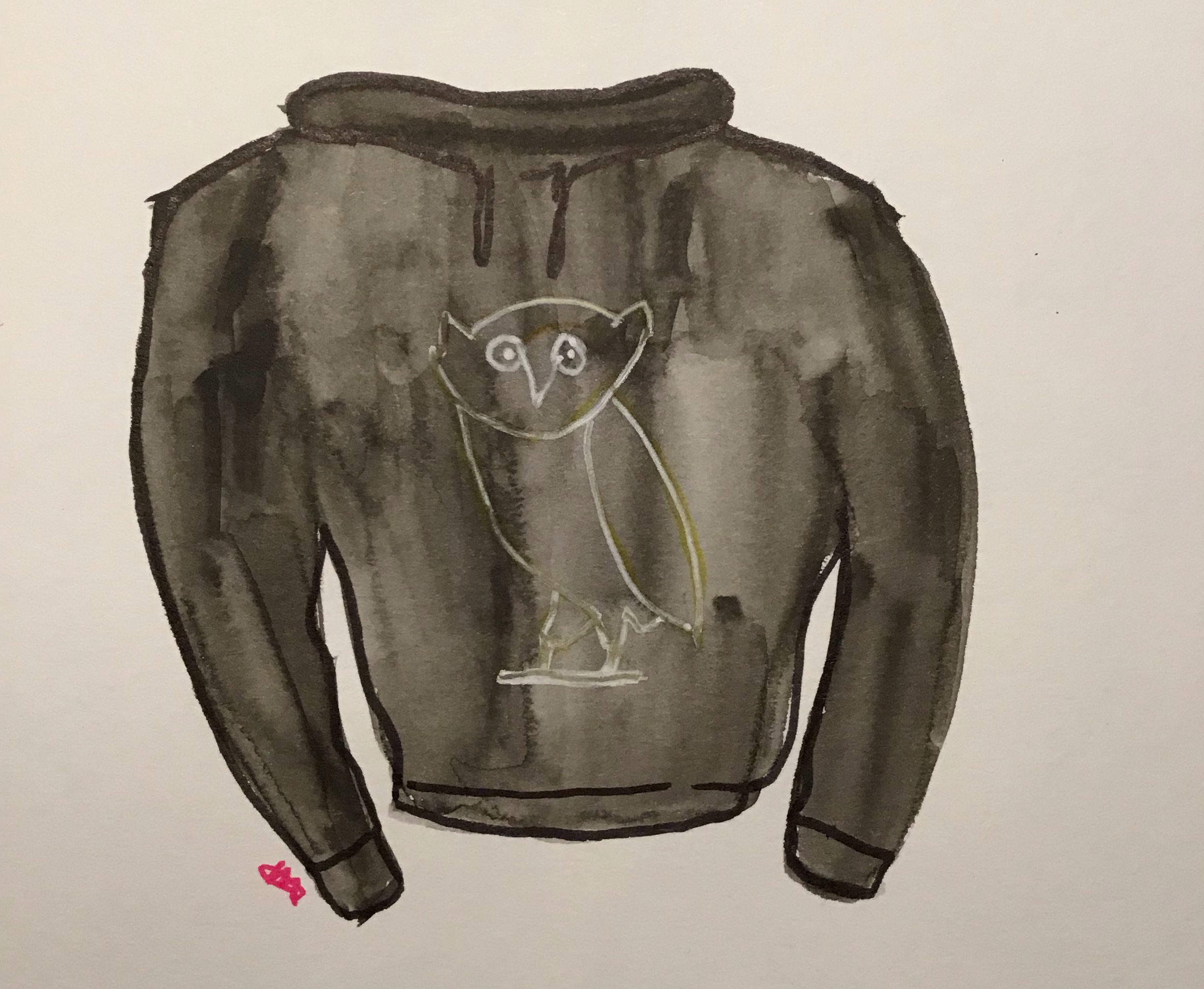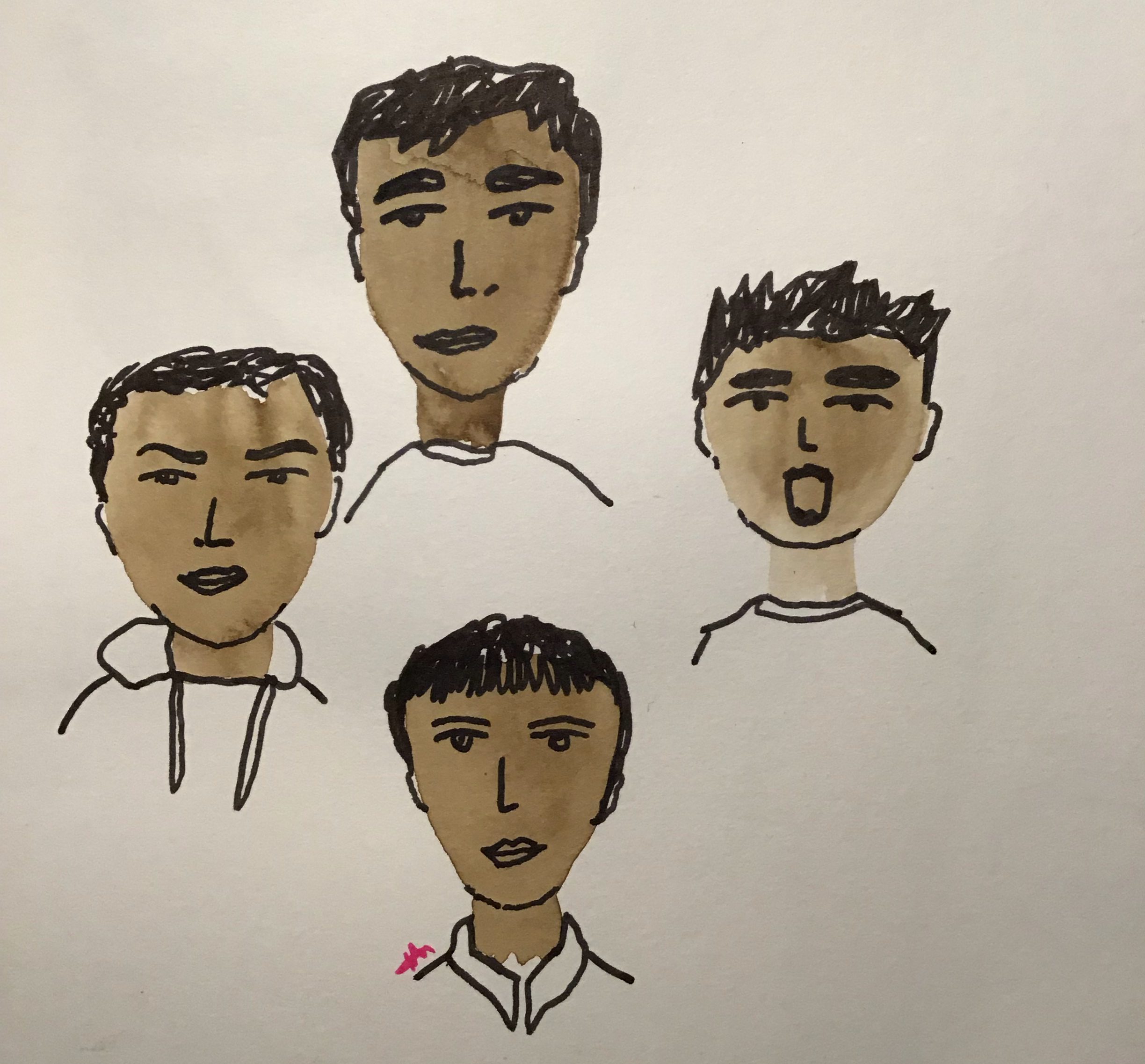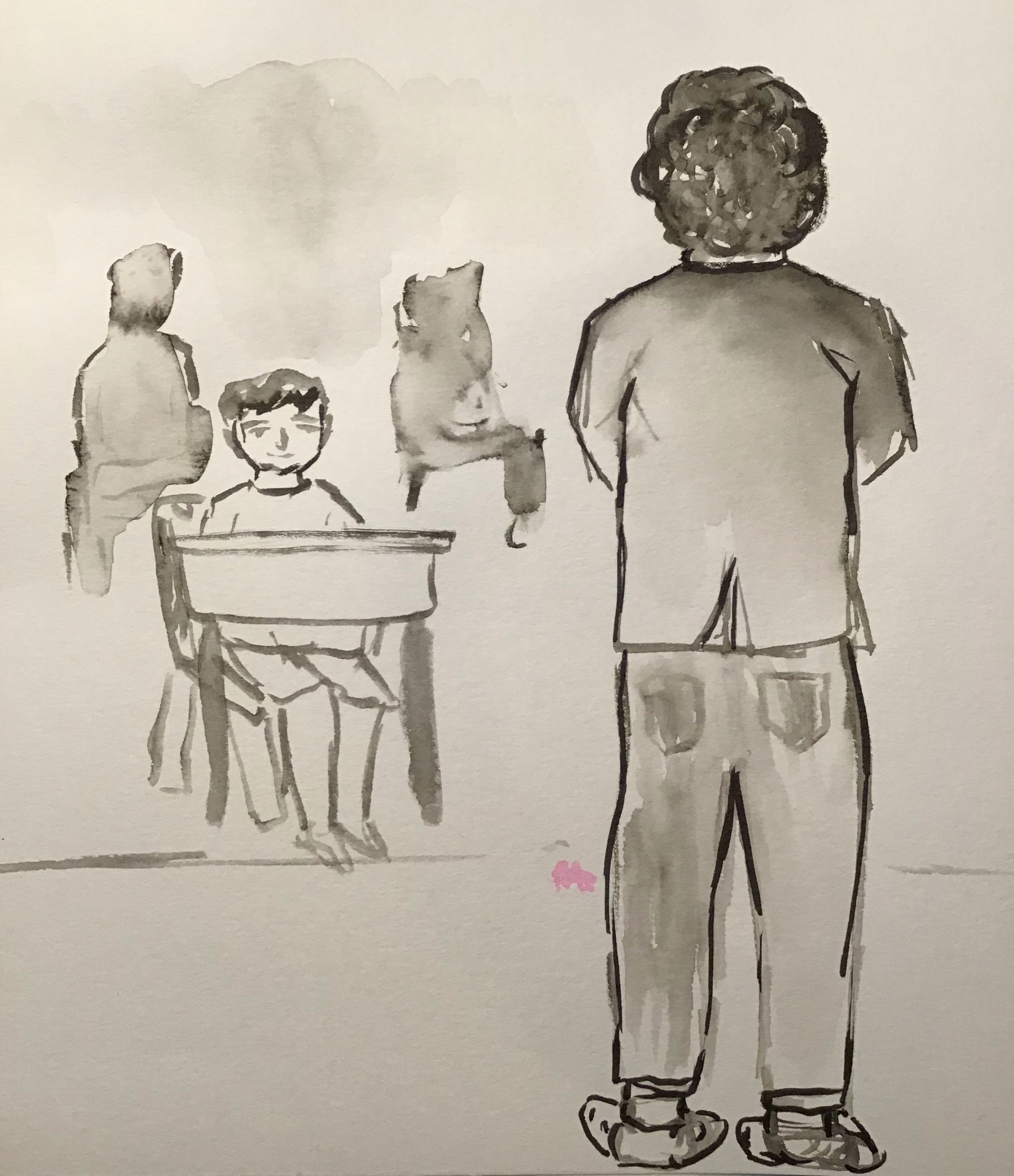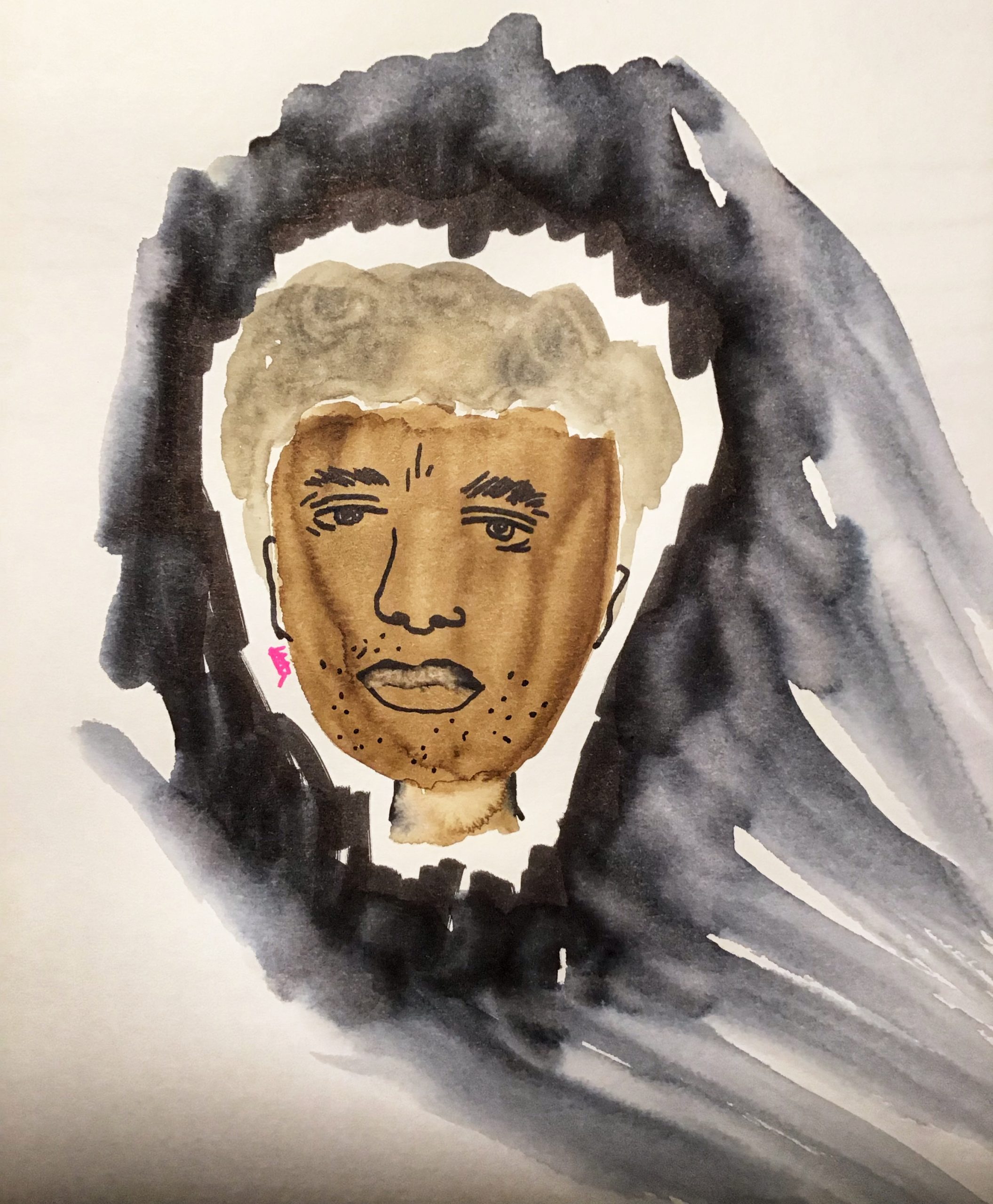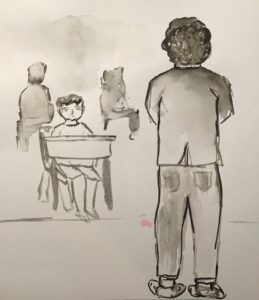
Overview:
2015—the president is Black, Young Jeezy’s Lambo is blue, and he’d be goddamned if his rims ain’t too, and you, first-year middle school English teacher, you fixate on a class you’d never taken. “Good Kids, Mad Cities,” taught by Adam Diehl, a professor at Georgia Regents University, and centered on the Kendrick Lamar album, good kid, m.A.A.d. city. You teach eleven-to-thirteen-year-old boys, children of wealthy Pakistani immigrants, in a small North Texas town. You’ve taught only once before and, even then, only for a summer. You’re still just a few weeks into the job. You need ideas. Inspiration. Guidance. Control. Yesterday, as the class read aloud from To Kill a Mockingbird, two students fell asleep, one snored, and another ended every line of dialogue by adding, “deez nuts,” even after returning from the office for that very same offense. Another student rocked back and forth in his seat, compulsively, it seemed, until he farted, and the other students mocked him—”Wallah! You smell like poop!”—and the farting student smiled, happy for attention in whatever form. Typically, they sit in silence whenever you ask questions about the novel. They’re bored, you justify.
In 2014, Diehl found a way to spice up his course description and get media coverage doing it. Diehl’s course was the first to utilize Kendrick Lamar at the university level, though not the first to present hip-hop in that setting. “[We] will examine the role of urban living on the development of young people,” the course description reads. “By studying and analyzing various literature, films, and K. Dot’s album, we will consider what effects our characters’ surroundings have on who they become as adults.” In an interview with Spin, he remarks, “it’d be a disservice to my literature brethren to not include any books,” and indeed, his syllabus features James Baldwin, Gwendolyn Books, and yes, of course, the most gangsta of all Irish writers, James Joyce. Well, shit, if Diehl can make Joyce hip-hop, then surely you can do the same with Atticus Finch.
Or, rather, he’s making Kendrick Lamar literary. “It’s like literature,” he says of good kid. “It’s a story, it’s got characters, themes, drama, and climaxes, everything that makes us love printed material.” And you agree. You’re not sure why Diehl, a white man, needs to defend the literary merit of Kendrick Lamar, but nevertheless, you agree with him. You can imagine how Lamar benefits Diehl. After all, he teaches at a university in Augusta, Georgia, a city with a staggering twenty-nine percent Black population. This seems motivation enough because, well, let’s be real—you also wanna jazz up the material a bit, give it a beat. You’ve gotta student who everyday wears his Drake hoodie, a large golden owl printed on the front gazing at you as you write him yet another office referral. One day, after school, you pose the question, “Who’s the better MC—Drake or Kendrick?” And pointing at his hoodie, he answers confidently, “Obvs Drake,” then adds, “But Kendrick has bars, too, I guess.”
Justification enough, you think, and the lesson plan takes shape in your mind. Though, your trepidation remains. You are reminded of a quote from King of the Hill, the gospel of Texas, about Christian rock. “Can’t you see you’re not making Christianity better?” Hank Hill quips to a wannabe hip youth minister, tattoo-clad and soul patched, “You’re just making rock and roll worse!” You fear you’ll do the same, combining your two messiahs—hip-hop and literature. And yes, indeed, Diehl reminds you of a youth minister. You are wary of youth ministers, though the few you’ve known have been pleasant—the way some (read: old white Republicans) might be wary of rappers, you suppose.
Diehl is pale with a dark black beard, scruffy and unkempt like the mop atop his head, but still, he tucks his dark blue button-up into a pair of nicely fit khakis, his thick-framed glasses poking out from the breast pocket. He has a slight Southern drawl and, in interviews, waxes poetic about hip-hop with all the confidence of a studied fan. Still, he approaches the subject always as a scholar, explaining elements of the genre—rap skits, for example—as if to the uninitiated. You wonder if he’s ever said, “nigga,” in class. And yet you’d like to get a beer with him. Pick his brain. “good kid or Pimp a Butterfly?” you’d ask him. You’d ask him which was more important to him—giving James Joyce street cred or sneaking Kendrick into the canon? You’d ask him how he would incorporate Kendrick Lamar into a middle school English class. And if, hey, you think maybe Harper Lee had bars, too?
Objective:
To survive, mostly. At least, initially. You see the job posted on Craigslist. “Help Wanted: Middle School English Instructor.” This is the first fall after undergrad. You are already desperate, having applied to a shit-ton of jobs. Even a technical writing position—a bank job. You knew early on you were not what they’d call, “the ideal candidate.”
“So, you photoshopped your face into a lot of pictures, I see,” writes the headhunter from the consulting firm after perusing your Facebook. And, indeed, you had. Rap album covers, mostly. At the time, your profile pic is your face crudely pasted onto the cover of the Kanye West album Graduation. You are making what your mom describes as “an obscene gesture”—tongue stuck out through a peace sign. “I guess you could call it a hobby,” you write back.
Still, you make it all the way to the final round of interviews. “Maybe try a more professional haircut,” the headhunter advises when he breaks the news that the bank chose the more experienced applicant, “and a more professional social media presence.” You run your fingers through what your mom has described as your nappy afro.
And so now you’ll be a teacher, you suppose. That summer, you taught a creative writing course for low-income, minority high schoolers—Black and Latinx, mostly. You liked it. You got some pretty good reviews from the students. You ran into one of them at a house show later that summer, jean jacketed punks pushing past the both of y’all to set up their amps. You hid the Shiner beer in your back pocket. He’s a Latino student, the son of Brazilian immigrants, and he has big, puffy hair like yours. You wonder if his mom ever call is it nappy, if that unites y’alls races. The student is dropping out of school, he informs you, but “I really dug your class, man.”
You see the job posting in September and wondered who would hire educators then—just a few weeks into the school year? And in a week or so, you arrive early to the little prep school that is.
For the interview, you wear a blue blazer, black slacks, a floral-patterned button-up, and a pair of sneakers. You have not, as the man from the consulting firm suggested, gotten a more professional haircut and, instead, are still sporting your afro.
You tell the woman interviewing you that you are passionate about teaching the classics because you can tell she wants you to be passionate about teaching the classics. “Which Shakespeare would you teach them?” she asks. You confirm that they’re middle schoolers, right? “Yes, could you handle Hamlet?” You tell her you’re passionate about Hamlet.
She walks you through the small, homey school to the class you’d be taking over. The kids seem calm as if they know they are being watched. Your potential predecessor, the eighth grade English teacher, barely fits in her main classroom but seems small in the lounge area where she hosts the English class. She’s a middle-aged white lady, reminiscent of just about every English teacher you’ve ever had. The class, however, is all brown faces—eight of ‘em and all boys—and she sticks out sorely. They sit in a circle, all uniformed in light blue button-ups tucked into dark blue slacks. You’ll learn later that the school is all Muslim students but is staffed mostly by middle-aged white ladies. The boys sit on couches; the teacher, on a recliner. They read from To Kill a Mockingbird as you observe. “Have you read it before?” the principal leans over and whispers to you. And yes, of course, you have. When you were in eighth grade.
Later, after the class has ended, the teacher tells you her brother is terminally ill. She stares past you to the whiteboard on the back wall. You don’t know her brother and now you know he is dying and you don’t know what to do with that information so you nod along as she speaks. Bags hang under her eyes. She tells you its hard to get the students to care sometimes, and you don’t understand exactly what she means but don’t ask her to clarify and just continue to nod along. “Some days, you just have to roll with the punches,” she tells you.
Once you take over, you understand what she meant. The new objective—just roll with the punches. But also, maybe, to break through to the students. Or is that misguided? You think about the student in the Drake hoodie. He plagiarized his last essay—from SparkNotes, no less—and he cried and cried, believing he’d be expelled as he sat in the office with you and the principal. “I just couldn’t think of anything to say,” he offered as explanation.
He reminds you of you at that age, though you’ve drank too much now to remember what you thought of To Kill a Mockingbird when it was assigned to you. You know he loves rap music though like you do, and did, and beyond that, you can relate to his indifference, to skimming through assigned books you tried and failed to read in grade school—all those white names, decades or centuries dead. And you think about the student you saw at that house show, who told you he just felt “suffocated by school, man.” You think that could’ve been you, too, equally as uninterested and as stifled by the material, but you had teachers who made the effort to reach out to you. One creative writing teacher even handed you a Gabriel Garcia Marquez book, One Hundred Years of Solitude, after class one day, saying your writing reminded her of the book, and that gesture carried you through the last two years of school. And so now you wonder not how much the student cared, but whether anyone else cared about him.
Required materials:
Set the book aside for a while. Harper Lee will forgive you. Use the song, “The Blacker the Berry.” Print the lyrics out. Sit with Sharpie in hand and blot out any word that might make the students giggle or Oooooh! For example, “My hair is nappy, my –––– is big, my nose is round and wide.” Practice hitting mute on the blotted words since you can’t yet find a censored version. You’re a musician. Consider it honing your rhythm.
Instructional plan:
Brief lecture (emphasis on brief as they’ll doze off quickly)—
Tom Robinson sits silently through most of the trial—the picture of perfect stoicism—occasionally raising his head or turning toward Atticus Finch when either of the Ewells accuse him or gesture in his direction. Tom Robinson remains silent throughout most of To Kill a Mockingbird, though his name is often on the lips of other characters. He speaks only when he’s called to the stand to testify. Tom Robinson is a Black man. Tom Robinson has been accused of raping a white woman, but Tom Robinson pleads innocent. Tom Robinson has powerful shoulders per Scout’s description. Tom Robinson is a “black velvet negro.” Tom Robinson looms large save for his left arm which is “fully twelve inches shorter than his right, and [hangs] dead at his side, [ending] in a small shriveled hand.” “If he had been whole,” Scout observes, “he would have been a fine specimen of a man.” Tom Robinson has only this stunted arm and its shriveled hand to offer in his defense.
Class discussion—
Pose to the students: “What would the novel be like if Tom had more of a voice?”
If they don’t respond (and they likely won’t), rephrase: “Does Tom have much of a voice in the novel?”
If still silent, try the even simpler: “How would you describe Tom Robinson?”
“He’s Black,” a student might joke. Savor the sound of their voice, any sound somewhat on beat with the lesson—the rhythm of participation. “And he’s like nice, I guess.”
(Diehl writes in his “Good Kid, Mad Cities” course description that the class “will include a substantial research paper” as if to suggest that it won’t be the blow-off class that some students might perceive a hip-hop oriented class to be. You, however, just want more sound in your class. You just wanna pimp the mockingbird out for something more than “deez nuts,” farts, and disinterested silence.)
Pose to the students: “What if Tom had a chance to express himself more?” Embrace the inevitable silence. The students don’t know where you’re going, and you wonder if even you know.
Stumble over introducing the song and connecting it to the material. It’s your style. Tell yourself that the awkwardness adds character. For context, add: “Hip-hop is Black expression… or a mode of it.” (And To Pimp a Butterfly excels because Kendrick blends so many different modes of Black expression throughout—jazz, soul, spoken word—but leave that out for fear of losing the students with the nerdy digression.)
Ask them if they’ve heard the song, “The Blacker the Berry,” or the album it’s from. Likely, they’ll say no, so ask them what rappers they do know and like, and why. Then, they’ll flow on beat. They like the hip-hop artists on the radio. The student in the Drake hoodie says he likes Drake. “Because he gets it,” he’ll say when asked why, and don’t press him on what “it” is.
Activity—
Pass out the blotted lyrics and ask students to identify the lines that resonate with Tom Robinson’s predicament. Play the song from laptop speakers, even though the low fidelity hurts your soul, because it’s all you have access to. Remember: keep your finger on the mute button. Don’t not refrain from bobbing along to the beat. Tell yourself it’s fine (maybe even desirable) to show some personality.
Ask the students what they’ve underlined. “You hate my people, your plan is to terminate my culture,” someone chimes in. “I know you hate me just as much as you hate yourself,” points out the principal’s son. “Cause like the Ewells or whatever,” he adds half-heartedly. “You made me a killer, emancipation of a real –––––,” Drake hoodie says, stopping short of saying “nigga,” maybe because you’ve censored it or maybe because he’s nervous.
Instruct them to pen bars of their own—from Tom Robinson’s perspective. Tom hasn’t yet died where the class is at in the text, and yet already you wanna resurrect him. They write lines of Tom Robinson aggressively asserting his innocence—out of character, maybe, but what do we really know of his character? Drake hoodie laments Tom Robinson as one of the “dead homies,” a common motif of Kendrick’s.
Provide time for them spit their bars over a generic beat found on YouTube. Make it a competition. (Sometimes, the prospect of winning motivates them.) You can have the school’s admin watch and act as an impartial judge.
Kendrick the students are not, but they might rival him in enthusiasm. They pump their fists or wave their hands overhead as if they’re commanding a stadium crowd to do the same. Drake hoodie crouches low, pretends as if he’s holding a mic, and forms his fingers into a gun—a tried and true rapper move since the 90s. The admin picks the principal’s kid. You’d have picked Drake hoodie but promise the principal’s kid a candy bar on Monday as reward and, anyway, his bars were as good—or as bad—as the rest of ‘em.
Reflection:
After class, Drake hoodie emails you a playlist. He says you gotta listen to more current stuff, man, even though To Pimp a Butterfly came out earlier that year. The songs on his playlist are all Billboard Top 100 rappers. You’ve heard most of them; they’re songs you like when they come on the radio though you never seek them out yourself, but it’s the gesture, not the songs, that matter to you. You will have homework. You, the teacher.
But no homework for the students, though the principal’s kid emails you, without prompting, a recorded version of his bars. He’s put it on his YouTube channel. “Like and subscribe,” he signs off.
The class will finish the novel next week, and Tom Robinson will die for another group of students—shot in the back, fleeing so-called “justice,” an all-too-common image caught now on cellphones and bodega security cameras. And, he will die off the page, his death relayed by a bunch of town gossips. “Did you hear about?… No? Well, they say he was runnin’ fit to beat lightnin’…” And, anyway, it wasn’t Tom Robinson who mattered but Boo Radley all along. Tom’s trial and death reveal that Boo, too, has been misunderstood. Tom dies so that one white girl can learn that people—white people—ain’t all so bad. And, anyway, at least the nasty old Ewells get theirs, too.
And, anyway, Tom Robinson had a voice outside of the courtroom. For your class, at least. Atticus Finch—and of course it’s Atticus Finch, paragon of virtue that he is—says it best: “You never really understand a person until you consider things from his point of view.” He’s also teaching a middle schooler, the impressionable and hard-headed Scout, and he’s teaching her about humanity and about empathy but he’s also giving voice to Harper Lee herself, teaching readers about what literature can do. Still, you can’t help but wonder, damn it, what if it were Tom Robinson’s story—his novel? Kendrick Lamar taught you that “Nigga, we gon’ be alright” and maybe Atticus Finch said the same to Tom Robinson but Lee never told you one way or the other because it wasn’t his story. Kendrick Lamar, though, he taught you that “if he got [Heaven] then you know you got it,” and, yes, indeed, him giving voice to the condition of your skin has been a helluva reassurance.
I don’t know if Diehl aimed to justify Kendrick Lamar’s rightful place in the literary canon or if he’s even arguing that Kendrick’s music is literature at all. Maybe that argument is implicit in the move itself. He’s said that it’s “like literature,” implying that the music is at least adjacent to the almighty novel. His syllabus places Kendrick next to literary titans and challenges students to note the similarities. But if Atticus Finch is right about literature revealing our innate humanity and empathy, then maybe the debate isn’t worth having at all. Maybe it is just best to hold all stories—so-called literature, hip-hop, and otherwise—side by side for what they might they say about each other and about ourselves. Maybe it’s best to always search for new stories, as we are always writing new stories, so that we never stop investigating that all-encompassing, pesky little thing we call humanity and how it shifts over time and how it stays the same.
What matters to you, above all, are voices. You were once an eighth-grade brown boy reading To Kill a Mockingbird and were before that a seventh-grade brown boy reading The Adventures of Huckleberry Finn and you considered Scout and Huck your friends because they sympathized with Black men who reminded you of your great grandpa, Cecil, who you met only a few times before he died at ninety years old but who always hugged you with the full weight of his years and all you’ve ever wanted was to be like him—to be a strong, wise, old Black man and to have the voice to match—though men like him were reduced to stereotypes in the books you read but yeah, you still liked Scout and Huck because they were on cusp of their preteen years like you and when they said, “nigger,” well, they said it with love and, hey, Huck even said he’d go to hell for Jim and it never occurred to you that you hadn’t read any Black characters or even any Black writers in grade school until you got to college and finally read a Toni Morrison novel, Beloved, and where the hell was this voice all your life! These real, resilient Black characters whose palpable flesh and blood in the text.
And, come to think of it, you didn’t have a Black educator—save for a football coach or two—until college either. Mostly middle-aged white ladies, just like your students. A report on nprED tells you that only two percent of teachers are Black males, and so it’s your students experiencing the unlikely statistical probability by having you as an instructor. You never having had a Black male teacher is the norm. But, hey, now there’s a class of brown boys who got exposed to a different voice for at least one class period and maybe there are classes of brown boys everywhere now without that revelation that you once had, blissfully unaware of its absence. You’ve started googling for books about young Muslim American boys on your downtime and maybe for some Muslim American rappers, too. You remember now what those college African American literature classes awakened in you, the veraciousness with which you then consumed the works of James Baldwin, Toni Morrison, W.E.B. Du Bois, among many, many others. That class sparked in you a love for literature just as a high school teacher, a white woman, handing you a Gabriel Garcia Marquez book once did. How that gesture compelled your pursuit of education—the book always occupying privileged space on a shelf wherever you study or teach. Literacy, you know firsthand, is a tool, is a motivator, is the beat of education. You wish there were a more diverse array of skin tones in front of whiteboards and blackboards everywhere, but whoever helms whatever classroom must consider deeply the best way to offer their students literacy.
And, anyway, it’s not just a job anymore. You aren’t sure if you can sustain this kind of work. You aren’t sure, for instance, if you can tie Jay-Z or whoever else to Hamlet, and thanks to your interview blunder, you’re slotted to teach the play in the next quarter. You are sure, however, that this is the work that needs to be done to combat the silences, whether it kills you or not. Atticus can’t speak for the brown kid who feels suffocated in a sea of whiteness, and so you and you and you and all y’all reading have been charged with helping brown kids find their voice. This lesson is your homework now. This lesson is a rallying cry set to a beat, and your class will no longer sit in silence.
***
Rumpus original art by Maryam Afaq Ansari.

